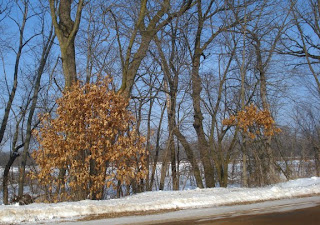Marcescent Bur Oak Leaves
along the Lower Chippewa River in Durand, Wisconsin
Coniferous trees, also called evergreens, have needles or scale-like leaves and cone bearing seeds. With the exception of tararack and baldcyress, conifers don't drop their foliage all at once in the fall.
A few deciduous trees - notably oaks, American Beech and Hop-hornbeam - hold on to their withered, lifeless leaves through the winter.
This has also been observed in young trees. This phenomena is called marcescence.
I never thought much about it - until recently, when I got interested in prairie vegetation. I've been looking at Bur Oaks lately: the corky ridges on their branches, the insect galls, their acorns, their resistance to fire and their marcescent leaves.
Why do they "break the rule" and hang on to their dead leaves all winter?
Some scientists have suggested that not dropping withered leaves may protect tree twigs, especially in young trees, from deer and other winter browsers.
Others suggest a downside: marcescent leaves, heavy with snow and ice, make tree branches vulnerable to breakage during storms.


No comments:
Post a Comment